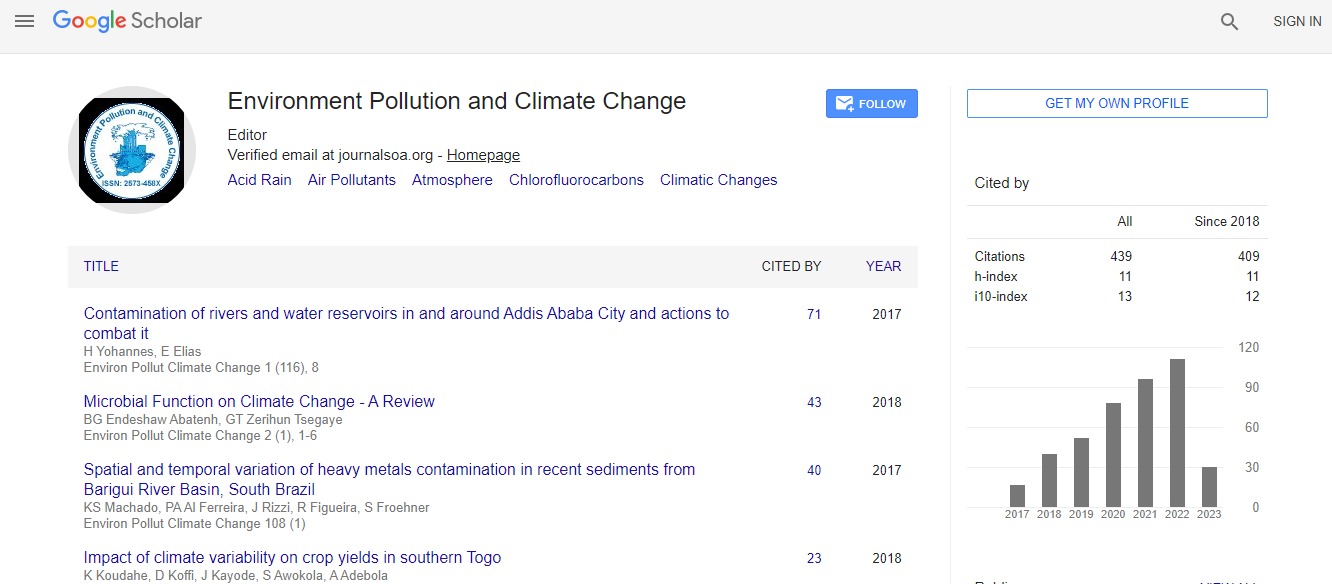Our Group organises 3000+ Global Conferenceseries Events every year across USA, Europe & Asia with support from 1000 more scientific Societies and Publishes 700+ Open Access Journals which contains over 50000 eminent personalities, reputed scientists as editorial board members.
Open Access Journals gaining more Readers and Citations
700 Journals and 15,000,000 Readers Each Journal is getting 25,000+ Readers
Google Scholar citation report
Citations : 672
Environment Pollution and Climate Change received 672 citations as per Google Scholar report
Environment Pollution and Climate Change peer review process verified at publons
Indexed In
- Google Scholar
- Publons
- Euro Pub
- ICMJE
Useful Links
Recommended Journals
Share This Page
Leveraging Autonomous Technology to Build Climate-Resilient Agriculture: A Case Study of Digital Cotton Field in China
Global Summit on Environmental Health
Justin Gong
Co-founder of XAG Co., LTD, China
ScientificTracks Abstracts: Environ Pollut Climate Change
Abstract
With the advent of the 5G era, the development of the Internet of Things, big data and artificial intelligence has brought a new definition to agriculture. Automation technologies, featuring drone, robot, and other unmanned system, can help ease farmers├ó┬?┬? workload and deliver efficiency, reliability, and productivity gains at minimal impact to the environment. However, although the technology advances fast, farmers are still facing great challenges. Labor shortage, climate change, misuse of chemicals could all lead to a bad yield and threaten environmental health. The purpose of this study is to analyze economic advantages and ecological benefits of the climate-smart agriculture ecosystem, which includes three steps: (1) Build digital farming infrastructure such as high-definition field maps and RTK navigation stations. (2) Develop precision farming equipment to reduce labor. (3) Help farmers connect all kinds of technologies in a digital platform and utilize big data and AI to make scientific decisions. The cost├ó┬?┬?benefit analysis and sensitivity analysis study were conducted for the comparison between traditional cotton fields and a digital corporate cotton farm. The result showed that at a certain critical size, the use of autonomous equipment can reduce the cost of production compared to traditional agriculture. Fixed equipment costs, labor costs, water costs and energy costs have a large impact on the critical size. On large-scale cotton farms, digital agriculture tends to be more economical than traditional agriculture. The GHG Protocol was also used to measure and calculate GHG emissions of the digital cotton field that was only managed by two people. A 22% reduction in GHG emissions was achieved through four main emission sources within the farm gate. In conclusion, unlike traditional methods that rely on experience and resources, the climate-smart management solution can reduce water consumption, pesticide, and fertilizer, lower input costs, and create new agricultural employment opportunities.Biography
Justin Gong is the Co-founder & Senior Vice President of XAG and a DBA candidate at Universite├?┬ü Paris Dauphine. As an entrepreneur specializing in rural economy and social innovation research, he has been dedicated to promoting and scaling up digital technology in agricultural production. He joined XAG as the Co-founder in 2013, taking charge of corporate strategy and marketing. Before returning to China, he was previously a film producer and overseas correspondent in Australia. In 2016, Justin Gong founded XAG Academy, which so far has trained about 80,000 talents for smart agriculture applications. In August 2018, Justin gate-crashed the Forbes China 30 Under 30, marking his contribution in the field of agriculture. With years of practical experience in the field of smart agricultural technology, he is also the 11th Council Board Member of Chinese Society of Agricultural Engineering, Grosvenor Council Member of National Geographic Society, and United Nations ESCAP-CSAM Consultant.

 Spanish
Spanish  Chinese
Chinese  Russian
Russian  German
German  French
French  Japanese
Japanese  Portuguese
Portuguese  Hindi
Hindi 
